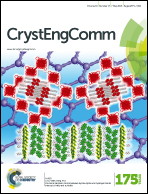The electrochemical properties, nitrogen adsorption, and photocatalytic activities of three 3D metal–organic frameworks bearing the rigid terphenyl tetracarboxylates ligands†
Abstract
Three new three-dimensional (3D) metal–organic frameworks (MOFs) derived from terphenyl tetracarboxylates, namely, [Mn(H2L)]n (1), {[Ni3(L)(μ3-OH)2(H2O)4]2·3H2O}n (2) and {[(CH3)2NH2]2[Zn(L)]·2DMF}n (3) (H4L = [1,1′:4′,1′′-terphenyl]-2′,4,4′′,5′-tetracarboxylic acid), were synthesized and characterized by elemental analyses, IR spectra, thermogravimetric (TG) analyses, powder X-ray diffraction (PXRD), and single-crystal X-ray diffraction. Complex 1 represents a 6-connected {412·63} framework, which contains 1D stair-type chain and 2D layer. Complex 2 displays the complicated {411·612·85}{42·6}{43·63}{43}{44·62}{48·66·8} topology, in which Ni–O chains play an important role in the whole framework. In complex 3, the wave-like and “H”-like 1D chains link each other to create the 3D architecture with {42·84} topology. The introduction of different metal ions and the diversities synthesis processes lead to the great differences of the final 3D frameworks. In addition, the fluorescence properties reveal that complex 3 containing ZnII possesses a fluorescent intensity, and complexes 1–2 based on MnII and NiII have no florescent activity. The electrochemical properties show that complex 2 possesses electrocatalytic activity for the reduction of nitrite. Photocatalytic properties indicate that complex 1 has good catalytic activity for the degradation of methylene blue (MB). Nitrogen adsorption reveals that complex 3 has adsorption property for nitrogen at 77 K.


 Please wait while we load your content...
Please wait while we load your content...